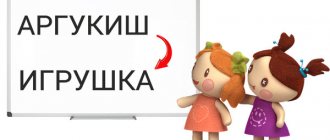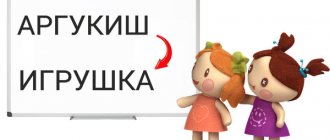Main types of memory
In psychology, memory refers to a number of abilities that record the experience gained, keep it in an active state, for reproduction in the future. The process involves the mechanisms of remembering, storing, reproducing and forgetting.
The development of memory affects the development of the child’s personality.
Information comes to the preschooler through the senses:
- visual - memorizing visible images;
- auditory - everything that the preschooler perceived through the organs of hearing;
- gustatory - memories of the taste of foods eaten;
- olfactory - remembering different aromas;
- tactile - sensations that were received during contact with an object.
Important! Each of the above types must be developed separately, by using the corresponding senses.
Based on duration, children's memory is divided into 2 types:
- Short-term. Information stays in the brain for a short period and disappears after a while. May only last 20-30 seconds.
- Long-term. The experience gained is retained for a long time. It can be mechanical or semantic.
The memory of a preschooler can be either involuntary (information is stored on its own) or voluntary (in order to remember something, you need to make an effort).
Types of memory
What memory predominates in preschool age
Each stage of memory development in preschool age has its own characteristics:
- Children from 0 to one year old develop motor memory quickly. Manifests itself in the form of conditioned reflexes. During this period, the baby observes the actions of his parents and tries to repeat them. Memorization will be effective if learning is accompanied by vivid emotions.
- From one to two years, the Central Unequal System develops. At this age, figurative memorization predominates. The baby recognizes the face of mom and dad and takes his first steps.
- At the age of 2-4 years, the rapid development of mechanical memory in children occurs. The child begins to remember words and think logically.
- In preschoolers aged 4-6 years, involuntary memorization is in the lead. They usually absorb information that seems interesting to them.
Over time, children’s memory mechanisms become stronger and the quality of their thinking improves. Children become more capable of learning.
Specific features of memorization in preschool age
Mechanical memory
Preschoolers have well-developed mechanical memory. They remember without much effort and then reproduce what they saw or heard. The main thing is that the information arouses interest. Sometimes it is called “cramming”; the semantic part of the material fades into the background. Vocabulary quickly improves and increases.
Why is it necessary to develop the memory of preschoolers
The baby doesn’t have to know and remember everything. But, thanks to a good memory, it will be easier for him to learn and live. The development of memory in preschool children improves the functioning of such processes as: attention, thinking, imagination. The older the child gets, the better the memory processes work. All this is due to the fact that the child improves the technique of assimilating new information.
GCD for drawing on the topic “My Dad” in senior groups of preschool educational institutions
Important! You need to train your memory at a very early age, this will give you the opportunity to apply the acquired skills and abilities in the future.
Minerals, vitamins and amino acids that help improve memory
- Vitamin C is the real king among vitamins, which is capable of increasing the mental activity of the brain, along with its other great abilities to work wonders in our body. Every child probably knows where vitamin C is found. And of course these are bell peppers, cabbage (especially sauerkraut), spinach, broccoli, many berries (currants, raspberries), rose hips, and of course citrus fruits.
- Choline, or vitamin B4, is used by the body to produce the neurotransmitter acetylcholine, which is essential for the normal functioning of all cells. Choline is especially important for brain function, as it affects areas of the brain responsible for memory functions and learning throughout life. Choline is also essential for transporting nutrients throughout the body, including the brain. Eggs are a rich source of choline and other sources include beef, cauliflower, wheat, peanuts and lettuce. Similar to taurine, choline is usually fortified in milk powder. Products containing choline - meat, milk, soy, egg yolk, cauliflower. These foods also contain other B vitamins, which also have a beneficial effect on brain function.
- Taurine is an amino acid that supports neurological development and increases memory power in children. Taurine is also believed to have antioxidant properties that help brain function. Taurine is found in meat, fish and breast milk. Most commercially produced dry formulas are fortified with taurine, since the body of young children deprived of breast milk does not have the ability to synthesize taurine from their diet. Regular cow's milk does not provide enough taurine.
- Folic acid reduces homocysteine levels, elevated levels of which have a bad effect on memory. Foods rich in folic acid include whole grains, soy, spinach, green peas, broccoli and oranges. There is ample research evidence to support the use of folic acid as a memory booster.
- Vitamin K (phylloquinone) strengthens the walls of blood vessels, protects them from destruction and gives them elasticity, prevents the development of atherosclerosis of all vessels, including brain vessels. It is known that this substance improves memory and activates mental activity. This vitamin is found in foods of plant origin - spinach, white cabbage, green tea and black tea, tomatoes, broccoli, dates, watercress, legumes and many others. etc. Among animal products, vitamin K contains beef liver, cod liver, eggs, and goat milk.
- Omega 3. The benefits of this polyunsaturated fatty acid are that it promotes brain development. Food sources of omega-3 fatty acids include fish oil and some vegetable or nut oils. Tuna, salmon and herring are also animal sources of Omega 3s. Peanuts, walnuts and almonds are also common sources of this fatty acid. For children who do not like to eat fish or nuts, fish oil is available in capsules or in the form of gelatin figures with different flavors.
- Magnesium is necessary for our body and brain, as it is an anti-stress substance, participates in the metabolism of fats, carbohydrates, proteins, transmission of nerve impulses, cleanses the body of toxins, and so on. This trace element improves memory and attention. Magnesium is found in almost all nuts, cereals, sprouted cereal grains, mustard, bananas, seaweed and legumes. Among vegetables, magnesium is found in sufficient quantities in broccoli, beets, avacados, onions and greens. Cocoa fruits and, accordingly, dark chocolate are also rich in magnesium.
- Selenium is a powerful antioxidant necessary for strengthening memory, as it protects nerve cells from their destruction. Selenium is found in herring, crab, garlic, oregano, olive oil, shrimp, porcini mushrooms, wheat germ and Brazil nuts.
Parents should also know that if a child has serious memory problems and it is very difficult for him to remember, it may be worth contacting a neuropsychologist.
Methods for developing different types of memory in preschoolers
Memory is one of the main mental processes, without which the development of a child’s intelligence is impossible. Many theses, coursework, and abstracts are devoted to this topic. Experts are developing new techniques and techniques that improve a child’s cognitive abilities.
Visual memory processes need to be trained and improved from an early age. The essence of the techniques used is to memorize and subsequently recognize images of animals, birds, plants, and flowers. For older children, they can choose cards with letters and numbers. You can train a preschooler's memory using simple techniques that include various exercises and games.
“What’s wrong here” exercise. There are from 4 to 7 pictures on the table, the child needs to remember what is shown on it. Then the baby turns around, the teacher or parent removes one picture. The baby needs to understand what has changed.
“What’s wrong here” exercise
The development of auditory memory can begin with studying the sound of musical instruments. Information is well absorbed while reading poems and sayings. New words will eventually enter the child’s active vocabulary.
To train your long-term memory, you can play “remember everything.” Let the baby remember and talk about the events of yesterday. The story should be as detailed as possible.
Methods for developing voluntary memory in preschoolers
Voluntary memory is aimed at remembering certain information; the child sets himself the task of first remembering and then remembering.
Important! The development of voluntary memory is one of the prerequisites for a child’s readiness to learn and learn at school.
The development of voluntary memory includes the following stages:
- target selection;
- listen carefully to the task;
- active memorization of necessary information.
For training, you can read ten unrelated words to a preschooler. Then, after reading, the child must reproduce them. Only correct answers are counted. This technique then allows you to observe how the child’s mental abilities develop over a certain period of time.
For this lesson you will need five different colored cards. Within fifteen minutes, the baby must remember where and how the cards are located. After which they are covered with a sheet of paper. The baby must place the colors one after another on his own. The answer is checked against the source.
Methods of memorizing poetry based on picture-graphic diagrams
The memory of preschoolers is characterized by the development of visual-figurative memorization. Young children are characterized by photographic ability, what they see is what they remember. This means that visual material is perceived better than verbal material. To remember a verse, a child needs to repeat it several times. To prevent children from losing interest in the poem, you can use pictures that make sense. After finishing listening, the baby can easily reproduce what he saw. This method speeds up the study of the poem.
Picture-graphic scheme for the nursery rhyme “Our Masha” by N. Burachevskaya
The success of the method of memorizing poetry based on picture-graphic diagrams depends on the formation of a semantic connection between the lines of the verse and the picture. The image helps the baby comprehend and repeat what he heard. Two or four lines are accompanied by a specific design.
Types of thinking in preschool children
Important! Learning poetry using pictures is suitable for teaching children with speech impairments and mental retardation (MDD). A special feature of the method is the improvement of long-term memorization and speech development.
Development of figurative memory in children
Figurative memory is closely related to remembering and reproducing past experiences. It is easier for children three to six years old to remember images; they can be either single or multiple.
Methods for developing figurative memory include:
- self-control;
- exercises;
- games;
- inclinations;
- interests.
The success of these techniques depends on the ability to arouse interest in children. For games, you should choose objects of complex shapes, bright colors, and various shades.
Figurative memory training
Group classes will be most effective. You can create a group from family members or involve children from the yard.
There are several training options:
- "Throw and catch." Preschoolers are divided into pairs. Each player is given a ball. After the word stop or number is heard, children throw a ball to a friend, the goal is to catch it.
- “Say the word.” The adult names the letter, the child must come up with a word for it. If the child does not know or is looking for the shortest path, he can use the hint of other participants.
Individual lessons are also useful. When going for a walk, the baby can list the clothes before putting them on. The baby, who does not see things, must name the colors and names.
Important! You can show pictures with different situations. One picture shows a real situation, the second a fictional one. The preschooler must name a fictitious situation. The child is read 10 or 12 words, from which it is necessary to compose a meaningful story.
How to make it easier to learn new information
It is difficult for a child without a good memory to achieve success. Easy memorization techniques will make it easier to learn new information:
- Reading books together with parents. Then there is a prediction of the text, a discussion of the characters. This technique develops curiosity and improves the learning process in a short time.
- Let the child learn the verse a couple of lines at a time, but every day until he has learned the whole thing.
- Vivid presentations make the learning process easier.
- Organizing a sleep and rest schedule helps to absorb information. This means that the more you need to remember, the better quality your sleep should be. The child should spend at least 2-3 hours outdoors.
- Some foods improve memory. The child's diet should include apples, grapes, avocados and dairy products.
The process of assimilation of new information largely depends on how much time parents devote to their child. The earliest memories are included in the process of personality formation; it is during this period that attention and memory predominate in preschoolers. Educational games, reading books, drawing and singing all contribute to the development of memorization.
Good relationships, care and attention improve a child's memory
If your family has good, friendly relationships, then your child will always remember new information with ease. Try to create a friendly environment in your family, peace, good relationships between parents and children, always have a positive effect on the development of the child’s memory and attention.
When a child sees good relationships in the family, with parents and other family members, then it is easier for him to study, he studies with joy. A child wants to study in a good environment at home and wants to please his parents and other relatives with his successes.
Create a good atmosphere in the family, love your child, spend a lot of time with him, surround him with care and affection, so that the child feels that he is not alone, that he is loved and will always help him.
When there are good relationships in the family, then everything turns out well for the child, his memory becomes better, and his head is not filled with quarrels between his parents.









